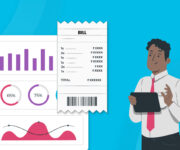Recent developments in computing power and advanced analytics, along with the rise of big data, enables businesses to be better at what they do and how they do it. More and more companies are leveraging the power of data to gain a comprehensive view of their businesses and make profitable decisions. When it comes to lending space, credit risk refers to the potential for loss due to the failure of a borrower to make a repayment when it is due.
Credit risk can involve complete or partial loss of principal, loss of interest, and disruption of cash flow for a lending company. Even risk managers at lending institutions can use the power of big data to identify, measure, and mitigate risk. By analyzing both internal and external data, risk managers can achieve accurate results about risks for the future. With the help of Machine learning algorithms, risk analytics can facilitate actionable insight from the massive amount of data generated from various sources for lending businesses. Modern risk management teams can evaluate risk in real-time and avoid costly delays with risk analytics powered by big data. While there can be no exact measure of the risk involved in the lending proposition, using analytics can help lenders build measurement parameters to establish and examine likely risk scenarios.
Why Every Lending Institution Needs to Leverage The Power of Risk Analytics?
Risk analytics allows tracking and analysis of risk factors in real-time, pointing out lending anomalies quickly and giving risk managers a chance to make changes to alleviate risks from the process.
- Using risk analytics helps the system shoot real-time alerts to risk managers when a problem arises.
- Allows real-time portfolio monitoring and performance evaluation across key parameters
- Machine learning algorithms help identify high-risk customers and reduce charge-off losses by critical screening.
- Risk analytics helps evaluate the potential impacts of possible trades, disruptions, and events and create portfolios that meet goals for profits and risk.
- Tracks credit breaches and even analyzes risk limit breaches by the trader, profit centre, and trading desk level.
How Risk Analytics Influence Customer Experience?

Lending institutions are radically improving their credit-risk models through risk analytics to achieve the motive of higher overall profitability. Risk analytics can revamp the business model of a lending firm, expanding its portfolio and creating new ways of serving their customers. Here are some significant ways in which risk analytics influence customer experience:
-
Minimal Manual Intervention Streamlines Loan Evaluation
Given the intense competition in the lending landscape, players who are still averse of the power of risk analytics tend to suffer. Then, to compensate for under-performing risk models, lending companies play safe with numerous business rules, policies as well as other manual interventions which hamper the quality of customer experience. Borrowers do not appreciate the manual interference that prolongs the evaluation phase of the loan assessment process. Modern lending businesses stand an opportunity to capture market share through a better experience and more precise targeting with the use of risk analytics. Using risk analytics, banks can automate the primarily manual processes—such as data capture and cleaning. Straight-through processing allows the creation of reports in near real-time. While risk management teams at the lender’s end can increasingly measure and mitigate risk more accurately and faster, customers benefit from streamlined origination.
-
Accurately Anticipate Customer Behaviour to Enhance CX
Detailed credit risk analysis provides lenders with a wholesome profile of the customer. Machine-learning techniques like deep learning, random forest, and XGBoost, are deployed in high-level risk-analytics departments. Lending businesses can use these insights to improve their own decision models and accurately anticipate customer behaviour. Risk analytics help lenders save their time, money, and resources, pointing them towards the right set of target customers. With this knowledge, lending institutions can offer an enhanced level of services to please their prospects.
-
Highly Personalized Lending Solutions
The only chance that modern lending companies have of locking in customers quickly given the intense competition is with highly personalized and desirable offerings to borrowers. Lending companies can tailor these ‘personalized’ offerings based on customer data gathered during risk analytics.
-
Unbiased Lending Decisions through Automated Risk Assessment
Some time even unrecognized biases on the part of the risk assessment team can deny a good borrower a fair chance to raise some money. Research shows that even the most rational and diligent decision approaches can be poor quality due to hidden biases. Every bias that influences the lending decision can end up in incorrect underwriting decision or poor pricing. While multiple biased choices can have a cumulative effect on the bank’s overall risk levels, they can also make for bad customer experience by denying loans to deserving applicants.
Risk analytics helps the risk assessment and decision-making process at the lender’s end be completely bias-free. Data backed credit decisions use fact-based inputs and are less error-prone than the ones made by humans.
-
Lend Customers with No Credit History
Risk analytics allow the vivid privilege of analyzing the risk level for those customers with little to no credit history. When lending institutions use risk analytics to evaluate loan applications in order to determine who is likely to pay their loans back and assess whether it’s a good investment or not, they often rely on unconventional and unstructured sources. These alternate sources of data range from customer data from utilities and supermarket loyalty cards to social media accounts and geospatial data etc. They also combine internal and external data sets to fabricate a proficient risk database. This helps borrowers without any significant credit history to avail loans without any hassle.
-
Lenders Offer Suitable Interest rates to Borrowers
Data from risk analytics can be used to predict better human behaviour, which empowers banks to improve their lending models. Financial lending institutions count social, legal, and economic factors to understand the underlying behaviours of the applicants better. The rule of thumb dictates that the higher the credit-risk perceived by the lender higher will be the interest rates for capital offered to a borrower. The traditional methods of credit analysis used to assess the creditworthiness of the borrower, organization, business or bond-issuer based on limited scored from credit rating institutes. However, using risk analytics brings out a wholesome picture, making data-backed credit-risk analysis an accurate fail-proof method. An accurate portrayal of risks involved allows customers to benefit from fair interest rate offered to them.
Conclusion
Advanced Risk analytics allows financial lending firms to restructure their operating principles to meet investment trends. While no doubt using analytical data along with various resources and programs can better analyze the risk of lending, incomplete databases are a reality. All lending institutions can develop a competitive edge through analytics by improving their current and serving the customers to their satisfaction.
Finezza is one unique lending management software that empowers lending companies with risk analytic capabilities to help them reap the benefits of effective assessment of applications. If you have any queries about the Finezza software, shoot a question in the comment section below, and we will get back to you.
To know more about Finezza, get in touch with us!




[…] neobanks are not known to have been targeted by hackers so far, their data is based on the cloud. On the customer end, neobanks use a variety of security measures including two-factor authentication and Role-Based […]